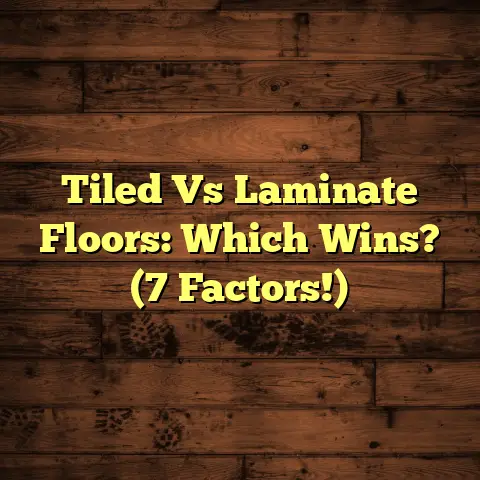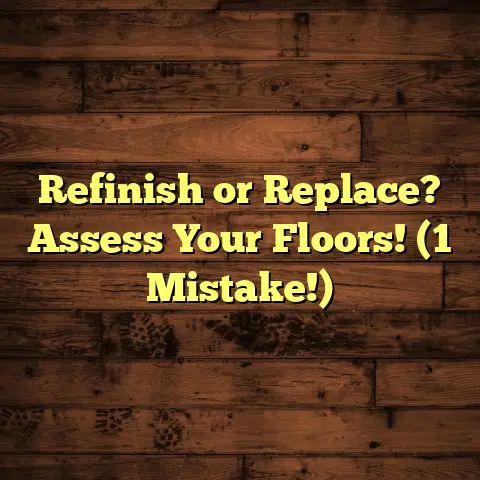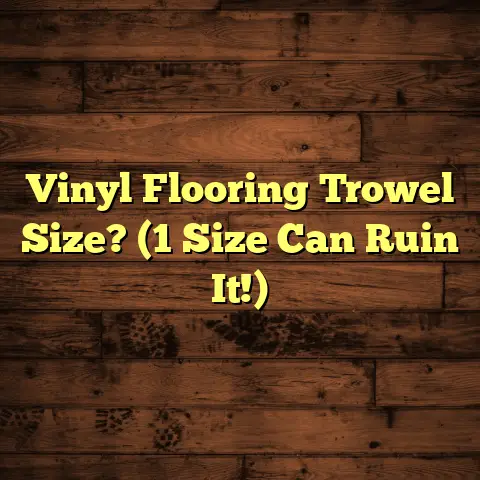Wood Floors On Concrete? (2 Prep Steps or Fail!)
Imagine this: you’re standing in a room
with a cold, gray concrete slab, dreaming
of transforming it into a warm, inviting
space with the timeless beauty of wood
flooring.
I get it!
I’ve been there, helping
countless homeowners just like you make
that dream a reality.
It sounds amazing, right?
But before you
jump headfirst into this exciting project,
let’s pump the brakes for a sec.
There’s a catch, a crucial “gotcha” that can
make or break your entire flooring endeavor:
two critical prep steps.
Seriously.
Skip them, and you’re practically begging
for a world of headaches, costly repairs,
and a wood floor that never quite lives up
to its potential.
Trust me, I’ve seen it
happen, and it’s not pretty!
In this article, I’m going to pull back the curtain and unravel the complexities of installing wood floors over concrete.
We’ll dive deep into why preparation is absolutely non-negotiable, the lurking pitfalls that await the unprepared, and those two essential steps you must take to ensure a stunning, long-lasting result.
Ready to turn that cold concrete into a
gorgeous wood haven?
Awesome!
Let’s get
started – this could save you from a
flooring disaster you won’t soon forget!
1. Understanding the Basics of Wood Floors on Concrete
Let’s start with the basics.
What are we
talking about when we say “wood flooring?”
Well, it’s pretty much what it sounds like:
flooring made from wood!
We’re talking
solid hardwood, engineered wood, even
bamboo (which, technically, is a grass, but
it acts a lot like wood).
People love wood flooring for a ton of
reasons.
It’s beautiful, adds warmth and
character to a room, and can even increase
your home’s value.
Plus, it comes in so
many different styles, colors, and finishes
that you can really customize the look to
match your personal taste.
But why are we even talking about concrete
in the first place?
Well, concrete slabs
are super common as subfloors, especially
in basements or on the ground floor.
They’re
strong, durable, and relatively inexpensive
to install.
Here’s the rub: wood and concrete don’t
always play nicely together.
Concrete is
porous, meaning it can absorb and release
moisture.
And as you probably know, moisture
is not a wood floor’s best friend.
This creates some unique challenges that you must address before even thinking about laying down that first plank.
The Unique Challenges of Wood on Concrete
Think of it like this: concrete is like a
sponge that can hold water.
Wood, on the
other hand, is like a… well, like a piece
of wood!
It expands and contracts with
changes in moisture.
Putting these two materials together without proper preparation is like putting oil and water together – they just don’t mix!
Here are a few of the specific challenges we’re talking about:
-
Moisture Migration: Concrete wicks moisture from the ground, and that moisture can then transfer to the wood flooring, causing it to warp, cup, or even rot.
-
Alkalinity: Concrete is alkaline, and high alkalinity can damage some types of wood flooring adhesives.
-
Uneven Surfaces: Concrete slabs aren’t always perfectly level, and any unevenness can cause problems with the installation.
Lack of Cushion: Concrete is hard!
Walking on wood flooring installed directly over concrete can be uncomfortable.
These challenges are real, folks.
But
don’t despair!
They’re all manageable with
the right preparation.
And that’s exactly
what we’re going to talk about next.
2. The Importance of Preparation
Okay, let’s get one thing straight: in the world of flooring, preparation is everything.
I’m not exaggerating here.
Whether you’re
installing hardwood, laminate, tile, or
anything else, taking the time to properly
prep the subfloor is the single most
important factor in ensuring a successful,
long-lasting installation.
Think of it like building a house: you
wouldn’t start framing the walls without
first laying a solid foundation, right?
Same goes for flooring.
With wood floors on concrete, proper preparation is even more critical because of the moisture issues we just talked about.
The Moisture Monster
Moisture is the bane of wood flooring.
It’s the arch-nemesis, the kryptonite, the
thing that keeps flooring contractors up at
night.
Okay, maybe that’s a slight
exaggeration, but you get the point.
Here’s why moisture is such a big deal:
Warping and Buckling: When wood absorbs moisture, it expands.
If it expands too much, it can warp, cup, or even buckle.
Imagine your beautiful new floor looking like a rollercoaster!-
Mold and Mildew: Moisture creates the perfect breeding ground for mold and mildew, which can not only damage your flooring but also pose a health hazard.
-
Adhesive Failure: Excess moisture can weaken or even dissolve the adhesive that’s holding your flooring in place, leading to loose planks and squeaky floors.
Reduced Lifespan: In general, moisture shortens the lifespan of your wood floor.
Instead of lasting for decades, it might only last for a few years.
I’ve seen firsthand the devastating effects
of moisture on wood floors.
I’ve ripped up
floors that were literally rotting from the
inside out, all because the homeowner didn’t
take the time to properly prepare the
concrete subfloor.
It’s heartbreaking to see, and it’s completely avoidable.
The Price of Neglect
So, what happens if you skip the prep work
and just slap that wood flooring directly
onto the concrete?
Well, let’s just say
it’s not a pretty picture.
Here are some of the potential consequences of improper preparation:
Warped or Buckled Floors: This is the most common problem.
You’ll start to notice the planks lifting up or cupping at the edges.-
Gaps Between Planks: As the wood dries out, it shrinks, leaving unsightly gaps between the planks.
-
Squeaky Floors: Loose planks rubbing against each other can create annoying squeaks every time you walk across the floor.
-
Mold and Mildew Growth: As we mentioned earlier, this can cause serious health problems and damage your home’s structure.
-
Complete Floor Failure: In severe cases, the entire floor might need to be ripped up and replaced.
I’m not trying to scare you, but I want you
to understand the real risks involved in
skipping the preparation steps.
It’s not
worth it!
Now that you understand why preparation is so important, let’s get down to the nitty-gritty and talk about the two critical steps you need to take.
3. Step 1: Assessing Moisture Levels
Alright, it’s time to get your hands dirty
(figuratively, of course!).
The first step
in preparing your concrete slab for wood
flooring is to assess the moisture levels.
This is absolutely crucial because, as we’ve
already established, excess moisture is the
enemy of wood flooring.
You need to know
how much moisture is present in the concrete
before you can move forward with the installation.
Methods for Testing Moisture Levels
There are several different methods you can
use to test the moisture levels in your
concrete slab.
Here are a few of the most
common:
Moisture Meter: This is probably the easiest and most accurate method.
You simply place the meter on the concrete surface, and it will give you a reading of the moisture content.
There are different types of moisture meters available, so be sure to choose one that’s specifically designed for concrete.
(I recommend a pin-type meter for the most accurate readings).Calcium Chloride Test (Anhydrous Calcium Chloride Test): This test involves placing a small container of calcium chloride on the concrete surface, sealing it with a plastic dome, and then waiting for a specific period of time (usually 72 hours).
The calcium chloride will absorb moisture from the concrete, and you can then weigh the container to determine how much moisture was absorbed.
(This test is very accurate but takes longer and requires more specialized equipment).Plastic Sheet Method: This is a simpler, less accurate method that you can use to get a general idea of the moisture levels.
Simply tape a piece of clear plastic sheeting (about 18″ x 18″) to the concrete surface and leave it for 24-48 hours.
If you see condensation forming underneath the plastic, it means there’s moisture present in the concrete.
I strongly recommend using a moisture meter for the most accurate results. The plastic sheet method can be helpful for a quick check, but it’s not reliable enough to base your entire installation on.
Acceptable Moisture Levels
So, you’ve tested the moisture levels in
your concrete.
Now what?
How do you know
if the levels are acceptable for wood
flooring installation?
The acceptable moisture levels will vary
depending on the type of wood flooring
you’re using and the manufacturer’s
recommendations.
However, here are some
general guidelines:
-
Moisture Meter Readings: Generally, you want the moisture content of the concrete to be below 4% using a pin-type moisture meter.
Calcium Chloride Test Results: The results are measured in pounds of moisture emitted per 1,000 square feet over 24 hours (lbs/1000 sq ft/24 hrs).
Typically, you want the moisture emission rate to be below 3 lbs/1000 sq ft/24 hrs for most wood flooring types.
Always consult the flooring manufacturer’s specifications for the most accurate information. They will have specific recommendations for moisture levels and testing methods.
What if your moisture levels are too high?
Don’t panic!
There are several things you
can do to lower them, such as:
-
Using a Dehumidifier: Running a dehumidifier in the room can help to dry out the concrete.
-
Improving Ventilation: Increasing ventilation in the room can also help to remove moisture.
-
Applying a Moisture Barrier: There are special coatings that you can apply to the concrete to create a moisture barrier.
It’s important to address any moisture issues before you install your wood flooring. Trying to cover them up or ignore them will only lead to problems down the road.
4. Step 2: Choosing the Right Underlayment
Okay, you’ve assessed the moisture levels in
your concrete and taken steps to address any
issues.
Now it’s time for the second
critical prep step: choosing the right
underlayment.
Underlayment is a layer of material that you
install between the concrete slab and the
wood flooring.
It serves several important
purposes, including:
-
Moisture Control: Underlayment can act as a moisture barrier, preventing moisture from the concrete from reaching the wood flooring.
-
Soundproofing: Underlayment can help to dampen sound and reduce noise transmission.
-
Insulation: Underlayment can provide some insulation, helping to keep your floors warmer in the winter and cooler in the summer.
-
Cushioning: Underlayment can add a layer of cushioning, making the floors more comfortable to walk on.
-
Leveling: Some types of underlayment can help to level out minor imperfections in the concrete slab.
Types of Underlayment Materials
There are many different types of
underlayment materials available, each with
its own advantages and disadvantages.
Here
are a few of the most common:
Foam Underlayment: This is a popular and relatively inexpensive option.
It’s available in a variety of thicknesses and densities and provides good cushioning and soundproofing.
However, it’s not always the best choice for moisture control.Cork Underlayment: Cork is a natural, sustainable material that offers excellent moisture resistance, soundproofing, and insulation.
It’s also a good choice for people with allergies, as it’s naturally resistant to mold and mildew.Vapor Barrier Underlayment: This type of underlayment is specifically designed to block moisture.
It’s typically made from polyethylene film or other waterproof materials.
Vapor barrier underlayment is a must if you’re installing wood flooring in a basement or other area prone to moisture.Combination Underlayment: Some underlayments combine multiple materials to provide a range of benefits.
For example, you might find an underlayment that combines foam with a vapor barrier.
Choosing the Right Underlayment
So, how do you choose the right underlayment
for your specific wood flooring type and
situation?
Here are a few tips:
-
Consider the Moisture Levels: If your concrete slab has high moisture levels, you’ll need to choose an underlayment that provides excellent moisture protection, such as a vapor barrier or cork underlayment.
-
Think About Soundproofing: If you’re installing wood flooring in an apartment or condo, you’ll want to choose an underlayment that provides good soundproofing to avoid disturbing your neighbors.
Consider the Type of Flooring: Some types of wood flooring require specific types of underlayment.
For example, some engineered wood floors require an underlayment with a specific density to ensure proper support.Read the Manufacturer’s Recommendations: As always, it’s important to read the flooring manufacturer’s recommendations for underlayment.
They will have specific guidelines for the type of underlayment that’s best suited for their product.Don’t Skimp on Quality: Underlayment is not the place to cut corners.
Investing in a high-quality underlayment will pay off in the long run by protecting your wood flooring and ensuring a long-lasting installation.
I’ve seen homeowners try to save a few bucks
by using cheap, inadequate underlayment, and
it always ends up costing them more in the
long run.
Don’t make the same mistake!
5. Common Mistakes to Avoid
Okay, we’ve covered the two critical prep
steps: assessing moisture levels and choosing
the right underlayment.
Now let’s talk about
some common mistakes that homeowners make
when installing wood floors on concrete.
Avoiding these mistakes can save you a lot of time, money, and frustration.
Skipping the Moisture Test: This is probably the biggest mistake of all.
Ignoring the moisture levels in your concrete is like playing Russian roulette with your flooring.
You might get away with it, but the odds are not in your favor.-
Using the Wrong Underlayment: Using an underlayment that’s not suitable for your specific flooring type or moisture conditions can lead to a variety of problems, including warping, buckling, and mold growth.
Not Acclimating the Wood Flooring: Wood flooring needs to acclimate to the humidity levels in your home before you install it.
This means leaving the unopened boxes of flooring in the room where they will be installed for at least 72 hours (and sometimes longer).
Failing to acclimate the flooring can cause it to expand or contract excessively after installation, leading to gaps between planks.Not Leveling the Concrete Slab: If your concrete slab is uneven, you’ll need to level it before installing the wood flooring.
You can use a self-leveling compound to fill in any low spots.Using the Wrong Adhesive: If you’re gluing down your wood flooring, you need to use an adhesive that’s specifically designed for that purpose.
Using the wrong adhesive can lead to bonding problems and loose planks.Not Following Manufacturer’s Instructions: This is a big one!
Always read and follow the flooring manufacturer’s instructions carefully.
They will have specific recommendations for installation, underlayment, and adhesive.
I can’t stress this enough: read the instructions! I know it’s tempting to just wing it, but you’ll be much better off if you take the time to understand the manufacturer’s recommendations.
I once had a client who ignored the
manufacturer’s instructions and installed his
wood flooring with the wrong adhesive.
A few
months later, the entire floor started to
buckle and come loose.
He had to rip it all
up and start over, costing him thousands of
dollars.
Don’t let that happen to you!
6. Installation Process Overview
Okay, you’ve assessed the moisture levels,
chosen the right underlayment, and avoided
the common mistakes.
Now it’s time to
actually install the wood flooring!
I’m not going to go into a ton of detail
on the installation process here, as it can
vary depending on the type of flooring
you’re using.
However, here’s a general
overview:
Prepare the Subfloor: Make sure the concrete slab is clean, dry, and level.
Remove any debris or loose material.Install the Underlayment: Follow the manufacturer’s instructions for installing the underlayment.
This usually involves rolling it out and taping the seams.-
Acclimate the Wood Flooring: As we mentioned earlier, it’s important to acclimate the wood flooring to the humidity levels in your home before installing it.
Install the Wood Flooring: There are several different ways to install wood flooring, including gluing it down, nailing it down, or using a floating installation method.
Follow the manufacturer’s instructions for your specific flooring type.-
Finishing Touches: Once the flooring is installed, you’ll need to install baseboards, transition strips, and other finishing touches.
Tools and Techniques
Here are a few recommended tools and techniques for installing wood flooring:
-
Moisture Meter: As we’ve discussed, this is essential for assessing moisture levels.
-
Self-Leveling Compound: This is used to level out uneven concrete slabs.
-
Tapping Block and Mallet: These are used to gently tap the planks into place during installation.
-
Spacers: These are used to maintain consistent spacing between the planks.
Saw: You’ll need a saw to cut the planks to size.
A miter saw is a good choice for making accurate cuts.-
Adhesive (if gluing down): Be sure to use an adhesive that’s specifically designed for wood flooring.
-
Safety Glasses and Gloves: Always wear safety glasses and gloves when working with power tools and adhesives.
Remember, safety first! Always follow the manufacturer’s instructions and take the necessary safety precautions when installing wood flooring.
7. Post-Installation Care and Maintenance
Congratulations!
You’ve successfully
installed your wood flooring over concrete.
Now it’s time to talk about how to care for
it and maintain it so that it looks great
for years to come.
Regular Cleaning: Sweep or vacuum your wood floors regularly to remove dirt and debris.
Use a soft-bristled brush or a vacuum with a felt attachment to avoid scratching the surface.Damp Mopping: Occasionally damp mop your wood floors with a mild soap and water solution.
Be sure to use a well-wrung-out mop to avoid getting too much water on the floor.Avoid Harsh Chemicals: Don’t use harsh chemicals, abrasive cleaners, or scouring pads on your wood floors.
These can damage the finish.-
Use Floor Protectors: Place felt pads underneath the legs of furniture to protect the floor from scratches.
Control Humidity: As we’ve discussed, moisture is the enemy of wood flooring.
Try to maintain a consistent humidity level in your home to prevent the flooring from expanding or contracting excessively.-
Avoid Standing Water: Clean up spills immediately to prevent water from seeping into the floor.
Re-Coat the Finish: Over time, the finish on your wood floors will wear down.
You can re-coat the finish every few years to protect the floor and keep it looking its best.
By following these simple care and maintenance tips, you can keep your wood floors looking beautiful for many years to come.
8. Conclusion: The Reward of Proper Preparation
Well, there you have it!
We’ve covered a lot
of ground in this article, but I hope you
now have a better understanding of the
importance of proper preparation when
installing wood floors over concrete.
Remember those two critical prep steps:
Assessing Moisture Levels: Don’t skip this step!
It’s essential to know how much moisture is present in the concrete before you start installing your flooring.-
Choosing the Right Underlayment: Select an underlayment that’s suitable for your specific flooring type and moisture conditions.
By taking the time to properly prepare your concrete slab, you can avoid a lot of potential problems and ensure a successful, long-lasting installation.
I know that preparation can seem like a
hassle, but trust me, it’s worth it in the
long run.
A little bit of effort upfront can
save you a lot of time, money, and
frustration down the road.
And the reward?
A beautiful, warm, inviting
wood floor that you can enjoy for many years
to come.
So go ahead, tackle that flooring project
with confidence!
You’re now equipped with
the essential knowledge to do it right.
And
who knows, maybe you’ll even enjoy the
process!
Happy flooring!





